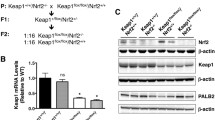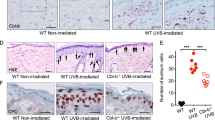Abstract
Basal cell carcinoma (BCC) and squamous cell carcinoma (SCC) are the most frequent tumors in the Caucasian population. The formation of these tumors is a consequence of long term UV-exposure of the skin. UV-light induces DNA damage in cells. If the damaged DNA cannot be repaired or the DNA damaged cell is not eliminated by apoptosis (so-called sunburn cells), cell transformation and tumor development can be the outcome. Fas-ligand (FasL), a member of the tumor necrosis superfamily, is a key molecule involved in the elimination of sunburn cells. FasL is expressed in normal skin epidermis, preferentially in the basal layer. Regulation of FasL expression has a dual effect on cancerogenesis. On the one hand, FasL expression is down regulated in skin epidermis by UV irradiation leading to the loss of its sensor function and thereby increasing the risk of cell transformation and skin tumor development. On the other hand, once BCC or SCC have developed, FasL is strongly up-regulated. High expression of FasL may now serve to protect the tumor from the attack of immune effector cells. To prove the immune escape hypothesis in vivo, the prevention or downregulation of FasL expression in tumor tissue is required. Two approaches were successfully applied to silence the FasL gene in BCC tissues ex vivo, the antisense technology and RNA interference with small interfering RNA duplexes. With both techniques FasL expression can be efficiently downregulated in BCC tissues pathing the way to test the immune escape hypothesis in vivo.
Access this chapter
Tax calculation will be finalised at checkout
Purchases are for personal use only
Preview
Unable to display preview. Download preview PDF.
Similar content being viewed by others
References
Tran H, Chen K, Shumack S. Epidemiology and aetiology of basal cell carcinoma. Br J Dermatol 2003; 149(Suppl 66):50–2.
Grossman D, Leffell DJ. The molecular basis of nonmelanoma skin cancer: New understanding. Arch Dermatol 1997; 133(10):1263–70.
Levine AJ. p53, the cellular gatekeeper for growth and division. Cell 1997; 88:323–31.
Soehnge H, Ouhtit A, Ananthaswamy ON. Mechanisms of induction of skin cancer by UV radiation. Front Biosci 1997; 2:D538–D51.
Ziegler A, Jonason AS, Leffell DJ et al. Sunburn and p53 in the onset of skin cancer [see comments]. Nature 1994; 372(6508):773–6.
Hahn H, Wicking C, Zaphiropoulous PG et al. Mutations of the human homolog of Drosophila patched in the nevoid basal cell carcinoma syndrome. Cell 1996; 85(6):841–51.
Johnson RL, Rothman AL, Xie J et al. Human homolog of patched, a candidate gene for the basal cell nevus syndrome. Science 1996; 272(5268):1668–71.
Stone DM, Hynes M, Armanini M et al. The tumour-suppressor gene patched encodes a candidate receptor for Sonic hedgehog. Nature 1996; 384(6605):129–34.
Grachtchouk M, Mo R, Yu S et al. Basal cell carcinomas in mice overexpressing Gli2 in skin. Nat Genet 2000; 24(3):216–7.
Bhardwaj A, Aggarwal BB. Receptor-mediated choreography of life and death. J Clin Immunol 2003; 23(5):317–32.
Kirkin V, Joos S, Zornig M. The role of Bcl-2 family members in tumorigenesis. Biochim Biophys Acta 2004; 1644(2–3):229–49.
Li HL, Zhu H, Xu CJ et al. Cleavage of BID by caspase 8 mediates the mitochondrial damage in the Fas pathway of apoptosis. Cell 1998; 94(4):491–501.
Hall PA, McKee PH, Menage HD et al. High levels of p53 protein in UV-irradiated normal human skin. Oncogene 1993; 8(1):203–7.
Henseleit U, Zhang J, Wanner R et al. Role of p53 in UVB-induced apoptosis in human HaCaT keratinocytes. J Invest Dermatol 1997; 109(6):722–7.
Hill LL, Ouhtit A, Loughlin SM et al. Fas ligand: A sensor for DNA damage critical in skin cancer etiology. Science 1999; 285(5429):898–900.
Bachmann F, Buechner SA, Wernli M et al. Ultraviolet light downregulates CD95 ligand and trail receptor expression facilitating actinic keratosis and squamous cell carcinoma formation. J Invest Dermatol 2001; 117(1):59–66.
Igney FH, Krammer PH. Immune escape of tumors: Apoptosis resistance and tumor counterattack. J Leukocyte Biol 2002; 71(6):907–20.
Buechner SA, Wernli M, Harr T et al. Regression of basal cell carcinoma by intralesional interferon-alpha treatment is mediated by CD95 (Apo-1/Fas)-CD95 ligand-induced suicide. J Clin Invest 1997; 100(11):2691–96.
Gutierrez-Steil C, Wrone-Smith T, Sun X et al. Sunlight-induced basal cell carcinoma tumor cells and ultraviolet-B-irradiated psoriatic plaques express Fas ligand (CD95L). J Clin Invest 1998;101(1):33–9.
Buechner SA, Wernli M, Bachmann F et al. Intralesional interferon in basal cell carcinoma. Rcecent Results in Cancer Research 2002; 160:246–50.
Kurreck J. Antisense technologies-Improvement through novel chemical modifications. Eur J Biochem 2003; 270(8):1628–44.
Varga LV, Toth S, Novak I et al. Antisense strategies: Functions and applications in immunology. Immunol Lett 1999; 69(2):217–24.
Elbashir SM, Lendeckel W, Tuschl T. RNA interference is mediated by 21-and 22-nucleotide RNAs. Genes Dev 2001; 15(2):188–200.
Elbashir SM, Harborth J, Lendeckel W et al. Duplexes of 21-nucleotide RNAs mediate RNA in terference in cultured mammalian cells. Nature 2001; 411(6836):494–8.
Dykxhoorn DM, Novina CD, Sharp PA. Killing the messenger: Short rnas that silence gene expression. Nat Rev Mol Cell Biol 2003; 4(6):457–67.
Shi Y. Mammalian RNAi for the masses. Trends Genet 2003; 19(1):9–12.
Ji JM, Wernli M, Buechner S et al. Fas ligand downregulation with antisense oligonucleotides in cells and in cultured tissues of normal skin epidermis and basal cell carcinoma. J Invest Dermatol 2003; 120(6):1094–99.
Ji JM, Wernli M, Klimkait T et al. Enhanced gene silencing by the application of multiple specific small interfering RNAs. Febs Lett 2003; 552(2–3):247–52.
Author information
Authors and Affiliations
Corresponding author
Rights and permissions
Copyright information
© 2006 Landes Bioscience and Springer Science+Business Media
About this chapter
Cite this chapter
Erb, P., Ji, J., Wernli, M., Büchner, S.A. (2006). Apoptosis and Cancerogenesis of Basal Cell and Squamous Cell Carcinoma. In: Molecular Mechanisms of Basal Cell and Squamous Cell Carcinomas. Medical Intelligence Unit. Springer, Boston, MA. https://doi.org/10.1007/0-387-35098-5_11
Download citation
DOI: https://doi.org/10.1007/0-387-35098-5_11
Publisher Name: Springer, Boston, MA
Print ISBN: 978-0-387-26046-4
Online ISBN: 978-0-387-35098-1
eBook Packages: Biomedical and Life SciencesBiomedical and Life Sciences (R0)




